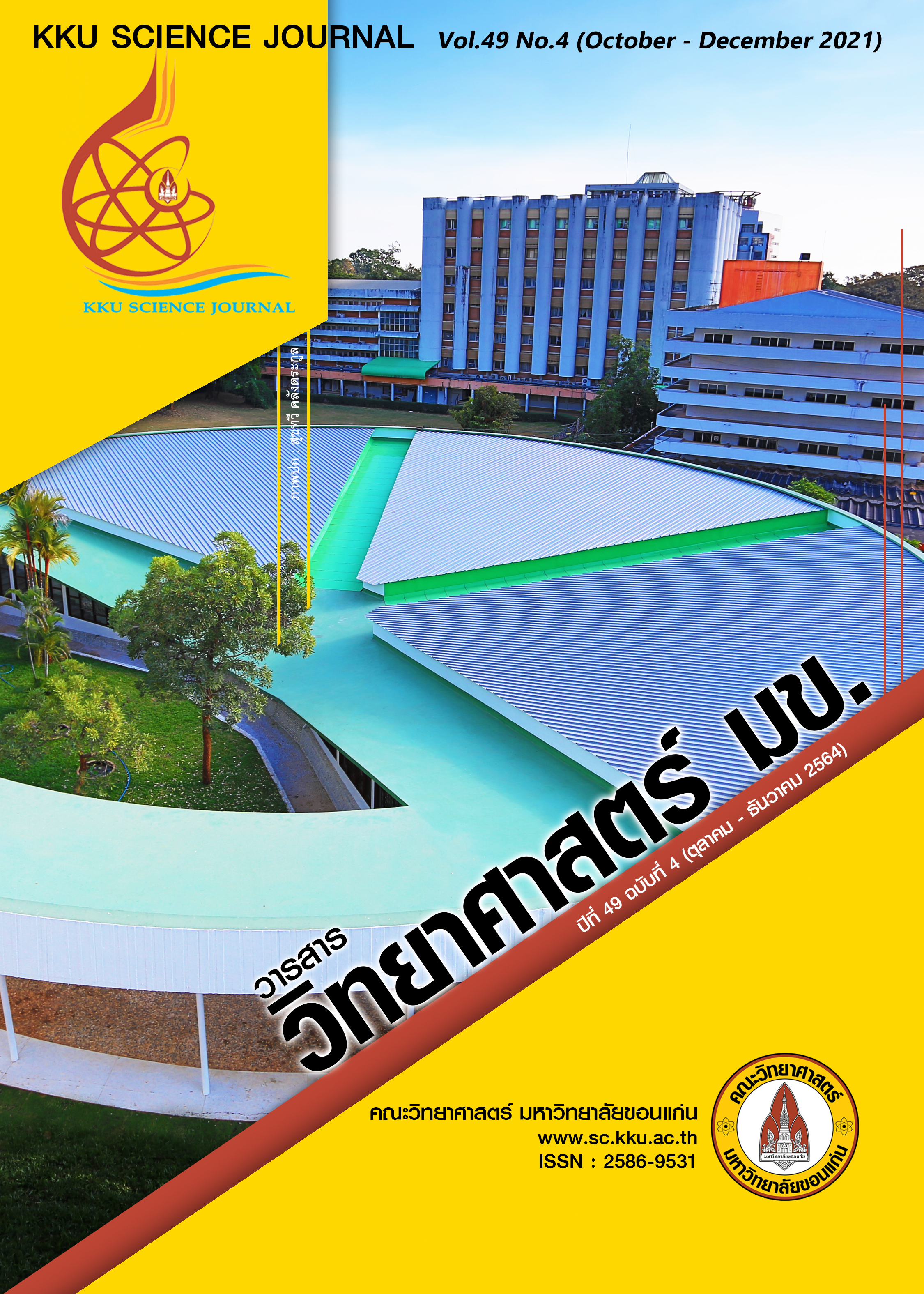Use of Unpolished Red Rice (Kaw Man Pu) Flour as A Substituted of Wheat Flour for Steamed Sponge Cake (Pui Fai) Production
Main Article Content
Abstract
This research was aimed to study on nutritional values of steamed sponge cake (Pui Fai) produced by partial substitution of wheat flour with unpolished red rice (Kaw Man Pu, KMP). Generally, KMP flour contained the contents of fat, ash, and fiber higher than that of wheat flour as 0.43, 0.56 and 3.58%, respectively. In addition, it provided high anthocyanin as 18.26 milligram per gram (dry weight). KMP flour was used to replace wheat flour for steamed sponge cake production at 0% (control), 15%, 30% and 45%. The result showed that the increase in wheat flour substitution with KMP flour affected on steamed sponge cake characteristics such as browning, softer, lower lightness (L*) and higher redness (a*) (p≤0.05). However, the replacement by KMP flour was unaffected on changes in size, specific volume, yellowness (b*) and textural properties (p>0.05). The sensory evaluation conducted by 9-point hedonic scale (50 panelists) showed that the sample with 30% substitution had the highest likeness scores for appearance, color, odor, softness, sweetness, aftertaste, and overall liking. For nutritional value, the chemical study of steamed sponge cake sample with 30% KMP flour contained higher the contents of fiber and anthocyanin than the control (p≤0.05). The KMP flour could substitute wheat flour for steamed sponge cake production with better nutritional value, but the improvement of some sensorial qualities of product should be considered.
Article Details

This work is licensed under a Creative Commons Attribution-NonCommercial-NoDerivatives 4.0 International License.
References
กล้าณรงค์ ศรีรอต และเกี้อกูล ปิยะจอมขวัญ. (2550). เทคโนโลยีของแป้ง. (พิมพ์ครั้งที่ 4). กรุงเทพฯ: สำนักพิมพ์มหาวิทยาลัยเกษตรศาสตร์. หน้า 105-110.
จารุวรรณ นามวัฒน์ และจันทร์เฉิดฉาย สังเกตุกิจ. (2560). การทดแทนแป้งสาลีด้วยแป้งข้าวกล้องในเค้กกล้วยหอม. ใน: การประชุมวิชาการระดับชาติ นวัตกรรมและเทคโนโลยีวิชาการ 2017 “วิจัยจากองค์ความรู้สู่การพัฒนาอย่างยั่งยืน”. คณะเกษตรศาสตร์และเทคโนโลยี คณะเทคโนโลยีการจัดการ มหาวิทยาลัยเทคโนโลยีราชมงคลอีสาน วิทยาเขตสุรินทร์, คณะวิทยาศาสตร์และเทคโนโลยีมหาวิทยาลัยสวนดุสิตและคณะเทคโนโลยีมหาวิทยาลัยราชภัฏอุดรธานี. มหาวิทยาลัยเทคโนโลยีราชมงคลอีสาน วิทยาเขตสุรินทร์, สุรินทร์. 493-499.
จิตธนา แจ่มเมฆ และอรอนงค์ นัยวิกุล. (2560). เบเกอรีเทคโนโลยีเบื้องต้น. (พิมพ์ครั้งที่ 13). กรุงเทพฯ: สำนักพิมพ์มหาวิทยาลัยเกษตรศาสตร์. หน้า 25-28.
ณัตฐาวุฒิ ฐิติปราโมทย์ นิสากร แซ่วัน ภาณุพงษ์ ใจวุฒิ ปัญญวัฒน์ ปันตาทอง นนท์ ธิติเลิศเดชา นัฏฐเนศวร์ ลับเลิศลบ และอัษฎาวุธ พิรัญรัตน์. (2555). ฤทธิ์ต้านอนุมูลอิสระของโปรแอนโทไซยานิดิน และแอนโทไซยานินจากข้าวที่มีสี 4 ชนิด. แหล่งข้อมูล: https://tarr.arda.or.th/preview/item/13301. ค้นเมื่อวันที่ 5 พฤษภาคม 2563.
นิธิยา รัตนาปนนท์. (2553). เคมีอาหาร. (พิมพ์ครั้งที่ 4). กรุงเทพฯ: โอเดยีน-สโตร์. หน้า 117, 321.
เพียรพรรณ สุภะโคตร ศิวพร แซ่เล้า และ อรวรรณ ใบศิลา. (2563). การทดแทนแป้งสาลีด้วยแป้งข้าวกล้องหอมมะลิแดงในผลิตภัณฑ์ขนมปัง. วารสารเกษตรพระวรุณ 17(2): 273-287.
รัขกฤช ภวธราปิยการ. (2562). ขนมอร่อยโดยครูตุ่ม. แหล่งข้อมูล: https://www.foodyas .com/TH/Amphoe-Ban-Pong. ค้นเมื่อวันที่ 2 พฤษภาคม 2563.
วรารัตน์ สานนท์ และดวงกมล แสงธีรกิจ. (2563). การพัฒนาผลิตภัณฑ์ขนมอาลัวแป้งข้าวหอมนิลเสริมสารสกัดน้ำอัญชัน. วารสารวิจัยและพัฒนา วไลยอลงกรณ์ ในพระบรมราชูปถัมภ์ สาขาวิทยาศาสตร์และเทคโนโลยี 15(3): 37-51.
โศรดา วัลภา กุลรภัส วชิรศิริ ดำรงชัย สิทธิสำอางค์ และ ฐิติชญา สุวรรณทัพ. (2553). ผลของการเสริมใยอาหารจากเปลือกทุเรียนต่อคุณภาพของขนมปังขาว. วารสารวิทยาศาสตร์เกษตร. 41(3/1พิเศษ): 205-208.
สำนักงานมาตรฐานผลิตภัณฑ์อุตสาหกรรม. (2552). มาตรฐานผลิตภัณฑ์ชุมชน ขนมไทย (มผช.1/2552). แหล่งข้อมูล: http://tcps.tisi.go.th/pub/tcp1_52.pdf. ค้นเมื่อวันที่ 2 พฤษภาคม 2564.
สายสนม ประดิษฐ์ดวง. (2551). ข้าวในมิติของอาหารต้านโรค. กรุงเทพฯ: ธนาเพรส. หน้า 13-25.
สุพิชญา คำคม. (2563). การทดแทนแป้งสาลีด้วยแป้งข้าวหอมนิลที่มีผลต่อลักษณะทางเคมีกายภาพ กิจกรรมการต้านออกซิเดชัน และการยอมรับทางประสาทสัมผัสของผลิตภัณฑ์หมั่นโถว. วารสารวิชาการและวิจัย มทร. พระนคร 14(2): 135-151.
Association of Official Analytical Chemists (AOAC). (2016). Official methods of analysis. 20th ed. Maryland: AOAC International. Cappelli, A., Oliva, N. and Civi, E. (2020). A systematic review of gluten-free dough and bread: dough rheology, bread characteristics, and improvement strategies. Applied Sciences 10(18): 6559.
Furner, S. (2020). From wheat to flour-a kitchen staple. Retrieved 13 March 2021 from https://www.utahfarmbureau.org/Article/From-Wheat-to-FlourA-Kitchen-Staple.
Gisslen, W. (2016). Professional baking. 7 th ed. U.S.A.: John Willey & Sons. Hartley, G. (2021). The ultimate guide to rice flour. Available from: https://fromthelarder.co.uk/white-rice-flour.
Juliette, S. (2016). Types of rice: the benefits, differences and the healthiest. Available from: https://www.huffingtonpost.com.au/2016/04/29/types-of-rice_n_9802746.html. Retrieved on 2 May 2020.
Lee, C.C., Hoseney, R. C. and Varriano-Marston, E. (1982). Development of a laboratory scale single stage cake Mix. Cereal Chemistry 59(2): 389-392.
Pakditawan, S. (2016). Thai steamed cupcakes: Khanom Pui Fai. Available from https://www.sirinyas-thailand.de/2016/01/04/thai-steamed-cupcakes-khanom-pui-fai. Retrieved on 2 May 2020.
Sukhonthara, S. (2017). Using brown rice flour and alternative sweetener to reduce glycemic index in toddy palm cake. Silapakorn University Science and Technology Journal 11(1): 17-26.
Wrolstad, R.E. (2000). Anthocyanins, in natural food colorants, Francis, F. J. and Lauro, G. J. (eds.). New York: Marcel Dekker.
Yamuangmorn, S., Dell, B. and Prom-u-thai, Ch. (2020). Anthocyanin and phenolic acid profiles in purple, red and non-pigmented rice during germination. Chiang Mai University Journal of Natural Sciences 19(4): 865-878.
Yeh, A.I. (2004). Preparation and application of rice flour. In Champagene E.T., ed. Rice: chemistry and technology. (3rd ed.) . Minnesota: American Association of Cereal Chemists, Inc. p. 495–539.


